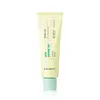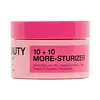What's inside
What's inside
 Key Ingredients
Key Ingredients

 Benefits
Benefits

 Concerns
Concerns

 Ingredients Side-by-side
Ingredients Side-by-side

Water
Skin ConditioningGlycerin
HumectantDipropylene Glycol
HumectantPropanediol
Solvent1,2-Hexanediol
Skin ConditioningNiacinamide
SmoothingNeopentyl Glycol Diheptanoate
EmollientMethyl Trimethicone
Skin ConditioningCetyl Alcohol
EmollientStearyl Alcohol
EmollientCoco-Caprylate/Caprate
EmollientDiisostearyl Malate
EmollientPhenyl Trimethicone
Skin ConditioningPalmitic Acid
EmollientHydroxyethyl Acrylate/Sodium Acryloyldimethyl Taurate Copolymer
Emulsion StabilisingStearic Acid
CleansingGlycereth-25 PCA Isostearate
EmulsifyingGlyceryl Stearate
EmollientAcrylates/C10-30 Alkyl Acrylate Crosspolymer
Emulsion StabilisingTromethamine
BufferingButylene Glycol
HumectantCoptis Japonica Extract
AntimicrobialXanthan Gum
EmulsifyingCeramide NP
Skin ConditioningEthylhexylglycerin
Skin ConditioningAdenosine
Skin ConditioningCitrus Aurantium Bergamia Fruit Oil
MaskingLavandula Angustifolia Oil
MaskingCentella Asiatica Extract
CleansingBifida Ferment Lysate
Skin ConditioningCitrus Aurantium Dulcis Peel Oil
MaskingAniba Rosaeodora Wood Oil
AstringentRosmarinus Officinalis Leaf Oil
MaskingEucalyptus Globulus Leaf Oil
PerfumingSodium Hyaluronate
HumectantCaprylic/Capric Triglyceride
MaskingAdansonia Digitata Seed Oil
EmollientHydrogenated Lecithin
EmulsifyingHyaluronic Acid
HumectantTocopheryl Acetate
AntioxidantTocopherol
AntioxidantSqualane
EmollientArtemisia Vulgaris Extract
Skin ConditioningAllantoin
Skin ConditioningCocos Nucifera Oil
MaskingPanthenol
Skin ConditioningHydrolyzed Collagen
EmollientCeramide Ns
Skin ConditioningCeramide As
Skin ConditioningMannitol
HumectantBentonite
AbsorbentCeramide EOP
Skin ConditioningCeramide AP
Skin ConditioningXylitylglucoside
HumectantAnhydroxylitol
HumectantHydrolyzed Hyaluronic Acid
HumectantXylitol
HumectantOlive Oil Decyl Esters
Camellia Sinensis Leaf Extract
AntimicrobialAnthemis Nobilis Flower Oil
MaskingCitrus Aurantifolia Fruit Extract
Skin ConditioningAdansonia Digitata Leaf Extract
Skin ConditioningCitric Acid
BufferingHydrated Silica
AbrasiveGlucose
HumectantPelargonium Graveolens Flower Oil
MaskingPseudoalteromonas Ferment Extract
HumectantMentha Viridis Leaf Oil
AstringentCaprylyl Glycol
EmollientLactic Acid
BufferingRose Flower Oil
MaskingCalendula Officinalis Extract
Skin ConditioningChamomilla Recutita Extract
Skin ConditioningPropolis Extract
Skin ConditioningSqualene
EmollientPalmitoyl Tripeptide-5
Skin ConditioningChlorella Minutissima Extract
Skin ConditioningAcetyl Tetrapeptide-11
Skin ConditioningPhellinus Linteus Extract
Skin ConditioningDipeptide Diaminobutyroyl Benzylamide Diacetate
Skin ConditioningMelissa Officinalis Leaf Extract
Skin ConditioningSerine
MaskingAlanine
MaskingProline
Skin ConditioningSodium Phosphate
BufferingSea Salt
AbrasiveAcetyl Hexapeptide-8
HumectantBeta-Glucan
Skin ConditioningSodium Hydroxide
BufferingMelaleuca Alternifolia Leaf Extract
PerfumingOligopeptide-1
Skin ConditioningDisodium EDTA
Water, Glycerin, Dipropylene Glycol, Propanediol, 1,2-Hexanediol, Niacinamide, Neopentyl Glycol Diheptanoate, Methyl Trimethicone, Cetyl Alcohol, Stearyl Alcohol, Coco-Caprylate/Caprate, Diisostearyl Malate, Phenyl Trimethicone, Palmitic Acid, Hydroxyethyl Acrylate/Sodium Acryloyldimethyl Taurate Copolymer, Stearic Acid, Glycereth-25 PCA Isostearate, Glyceryl Stearate, Acrylates/C10-30 Alkyl Acrylate Crosspolymer, Tromethamine, Butylene Glycol, Coptis Japonica Extract, Xanthan Gum, Ceramide NP, Ethylhexylglycerin, Adenosine, Citrus Aurantium Bergamia Fruit Oil, Lavandula Angustifolia Oil, Centella Asiatica Extract, Bifida Ferment Lysate, Citrus Aurantium Dulcis Peel Oil, Aniba Rosaeodora Wood Oil, Rosmarinus Officinalis Leaf Oil, Eucalyptus Globulus Leaf Oil, Sodium Hyaluronate, Caprylic/Capric Triglyceride, Adansonia Digitata Seed Oil, Hydrogenated Lecithin, Hyaluronic Acid, Tocopheryl Acetate, Tocopherol, Squalane, Artemisia Vulgaris Extract, Allantoin, Cocos Nucifera Oil, Panthenol, Hydrolyzed Collagen, Ceramide Ns, Ceramide As, Mannitol, Bentonite, Ceramide EOP, Ceramide AP, Xylitylglucoside, Anhydroxylitol, Hydrolyzed Hyaluronic Acid, Xylitol, Olive Oil Decyl Esters, Camellia Sinensis Leaf Extract, Anthemis Nobilis Flower Oil, Citrus Aurantifolia Fruit Extract, Adansonia Digitata Leaf Extract, Citric Acid, Hydrated Silica, Glucose, Pelargonium Graveolens Flower Oil, Pseudoalteromonas Ferment Extract, Mentha Viridis Leaf Oil, Caprylyl Glycol, Lactic Acid, Rose Flower Oil, Calendula Officinalis Extract, Chamomilla Recutita Extract, Propolis Extract, Squalene, Palmitoyl Tripeptide-5, Chlorella Minutissima Extract, Acetyl Tetrapeptide-11, Phellinus Linteus Extract, Dipeptide Diaminobutyroyl Benzylamide Diacetate, Melissa Officinalis Leaf Extract, Serine, Alanine, Proline, Sodium Phosphate, Sea Salt, Acetyl Hexapeptide-8, Beta-Glucan, Sodium Hydroxide, Melaleuca Alternifolia Leaf Extract, Oligopeptide-1, Disodium EDTA
Water
Skin ConditioningGlycerin
HumectantDimethicone
EmollientButyrospermum Parkii Butter
Skin ConditioningCaprylic/Capric/Myristic/Stearic Triglyceride
EmollientC12-15 Alkyl Benzoate
Antimicrobial3-O-Ethyl Ascorbic Acid
Skin ConditioningTapioca Starch
Cetearyl Alcohol
EmollientArachidyl Alcohol
EmollientSqualane
EmollientCoco-Caprylate/Caprate
EmollientPentaerythrityl Tetraisostearate
EmollientTridecyl Trimellitate
EmollientPalmitoyl Tetrapeptide-7
Skin ConditioningPalmitoyl Tripeptide-1
Skin ConditioningTetrahexyldecyl Ascorbate
AntioxidantCeramide NP
Skin ConditioningCaprylyl Glycol
EmollientCaprylyl/Capryl Glucoside
CleansingLinoleic Acid
CleansingCitric Acid
BufferingPhytosterols
Skin ConditioningGlucose
HumectantSodium Acrylate/Sodium Acryloyldimethyl Taurate Copolymer
Emulsion StabilisingBehenyl Alcohol
EmollientPolyisobutene
Bis-Diglyceryl Polyacyladipate-2
EmollientHydroxyacetophenone
Antioxidant1,2-Hexanediol
Skin ConditioningCetearyl Glucoside
EmulsifyingArachidyl Glucoside
EmulsifyingCarrageenan
Sorbitan Laurate
EmulsifyingSodium Phytate
C18-36 Acid Glycol Ester
EmollientC18-36 Acid Triglyceride
EmollientWater, Glycerin, Dimethicone, Butyrospermum Parkii Butter, Caprylic/Capric/Myristic/Stearic Triglyceride, C12-15 Alkyl Benzoate, 3-O-Ethyl Ascorbic Acid, Tapioca Starch, Cetearyl Alcohol, Arachidyl Alcohol, Squalane, Coco-Caprylate/Caprate, Pentaerythrityl Tetraisostearate, Tridecyl Trimellitate, Palmitoyl Tetrapeptide-7, Palmitoyl Tripeptide-1, Tetrahexyldecyl Ascorbate, Ceramide NP, Caprylyl Glycol, Caprylyl/Capryl Glucoside, Linoleic Acid, Citric Acid, Phytosterols, Glucose, Sodium Acrylate/Sodium Acryloyldimethyl Taurate Copolymer, Behenyl Alcohol, Polyisobutene, Bis-Diglyceryl Polyacyladipate-2, Hydroxyacetophenone, 1,2-Hexanediol, Cetearyl Glucoside, Arachidyl Glucoside, Carrageenan, Sorbitan Laurate, Sodium Phytate, C18-36 Acid Glycol Ester, C18-36 Acid Triglyceride
Ingredients Explained
These ingredients are found in both products.
Ingredients higher up in an ingredient list are typically present in a larger amount.
1,2-Hexanediol is a synthetic liquid and another multi-functional powerhouse.
It is a:
- Humectant, drawing moisture into the skin
- Emollient, helping to soften skin
- Solvent, dispersing and stabilizing formulas
- Preservative booster, enhancing the antimicrobial activity of other preservatives
Caprylyl Glycol is a humectant and emollient, meaning it attracts and preserves moisture.
It is a common ingredient in many products, especially those designed to hydrate skin. The primary benefits are retaining moisture, skin softening, and promoting a healthy skin barrier.
Though Caprylyl Glycol is an alcohol derived from fatty acids, it is not the kind that can dry out skin.
This ingredient is also used as a preservative to extend the life of products. It has slight antimicrobial properties.
Learn more about Caprylyl GlycolCeramide NP is a type of ceramide and formally known as ceramide 3.
Ceramides are intercellular lipids naturally found in our skin that bonds dead skin cells together to create a barrier. They are known for their ability to hold water and thus are a great ingredient for dry skin.
Ceramides are an important building block for our skin barrier. A stronger barrier helps the skin look more firm and hydrated. By bolstering the skin ceramides act as a barrier against irritating ingredients. This can help with inflammation as well.
If you would like to eat ceramides, sweet potatoes contain a small amount.
Read more about other common types of ceramides here:
Ceramide AP
Ceramide EOP
Citric Acid is an alpha hydroxy acid (AHA) naturally found in citrus fruits like oranges, lemons, and limes.
Like other AHAs, citric acid can exfoliate skin by breaking down the bonds that hold dead skin cells together. This helps reveal smoother and brighter skin underneath.
However, this exfoliating effect only happens at high concentrations (20%) which can be hard to find in cosmetic products.
Due to this, citric acid is usually included in small amounts as a pH adjuster. This helps keep products slightly more acidic and compatible with skin's natural pH.
In skincare formulas, citric acid can:
While it can provide some skin benefits, research shows lactic acid and glycolic acid are generally more effective and less irritating exfoliants.
Most citric acid used in skincare today is made by fermenting sugars (usually from molasses). This synthetic version is identical to the natural citrus form but easier to stabilize and use in formulations.
Read more about some other popular AHA's here:
Learn more about Citric AcidCoco-Caprylate/Caprate is created from fatty coconut alcohol, caprylic acid, and capric acid.
It is a lightweight emollient. Emollients create a thin barrier on the skin to trap moisture in. This helps keep your skin hydrated and soft.
Once applied, Coco-Caprylate/Caprate is absorbed quickly and leaves a silky feel.
Coco-Caprylate/Caprate may not be fungal acne safe.
Learn more about Coco-Caprylate/CaprateGlucose is a simple sugar and is the most important source of energy in all organisms.
In skincare, glucose is used to hydrate the skin. It also acts as a prebiotic for our natural biome.
Glucose is hydrating due to its humectant property. As a humectant, glucose draws moisture from the air and from deeper levels in the skin.
Our skin contains many sugars that act as prebiotics and help strengthen our natural microbiome. Having a healthy microbiome helps protect our skin from harmful bacteria and other contaminants.
Studies show glucose may help with fading discoloration and pigmentation. This is because our skin metabolizes glucose into lactic acid. Lactic acid is an AHA that helps exfoliate the top layer of skin.
Learn more about GlucoseGlycerin is already naturally found in your skin. It helps moisturize and protect your skin.
A study from 2016 found glycerin to be more effective as a humectant than AHAs and hyaluronic acid.
As a humectant, it helps the skin stay hydrated by pulling moisture to your skin. The low molecular weight of glycerin allows it to pull moisture into the deeper layers of your skin.
Hydrated skin improves your skin barrier; Your skin barrier helps protect against irritants and bacteria.
Glycerin has also been found to have antimicrobial and antiviral properties. Due to these properties, glycerin is often used in wound and burn treatments.
In cosmetics, glycerin is usually derived from plants such as soybean or palm. However, it can also be sourced from animals, such as tallow or animal fat.
This ingredient is organic, colorless, odorless, and non-toxic.
Glycerin is the name for this ingredient in American English. British English uses Glycerol/Glycerine.
Learn more about GlycerinSqualane is an emollient that helps the skin hold onto moisture. It's an oily liquid that occurs naturally in certain types of fish and plant oils.
Because squalane boosts hydration in the skin, it also comes with plenty of benefits: it is an antioxidant and can help fight free radicals and skin damage. Squalane is also found to have a detoxifying effect when applied.
Squalane comes from squalene, which occurs naturally within the sebum of our skin. It is one of the oils our skin produces to keep itself hydrated. Squalane is the hydrogenated version of squalene and has a longer shelf life.
Research shows that squalane is non-irritating (even at 100% concentration).
In general, it's a fantastic ingredient. It does a great job at hydrating the skin, and it's suitable for those with sensitive skin.
The source of squalane may impact malassezia / fungal acne. This is because olive oil derived squalane can contain impurities such as fatty acids and plant waxes. Sugarcane derived squalane is recommended for anyone with malassezia concerns.
Is squalane vegan?
This depends on the source. Squalane can be derived from both plants and animals. Most squalane used in skincare comes from plants.
Please note: the source of squalane is only known if disclosed by the brand. We recommend reaching out to the brand if you have any questions about their squalane.
Read more about squalene with an "e".
Is squalane an oil?
Squalane is often called an oil, but it’s technically not; it’s a hydrocarbon, meaning it’s only made of carbon and hydrogen, unlike true oils which are triglycerides made of fatty acids and glycerol.
The term “oil-free” isn’t regulated, so companies can define it however they want. Some exclude all oils, while others just avoid mineral oil or comedogenic oils.
While some people avoid oils thinking they cause breakouts, the right kind of oil (or oil-like ingredient like squalane) can actually help balance and hydrate your skin. It’s worth testing out simple oils or squalane to see what works best for your skin.
Learn more about SqualaneWater. It's the most common cosmetic ingredient of all. You'll usually see it at the top of ingredient lists, meaning that it makes up the largest part of the product.
So why is it so popular? Water most often acts as a solvent - this means that it helps dissolve other ingredients into the formulation.
You'll also recognize water as that liquid we all need to stay alive. If you see this, drink a glass of water. Stay hydrated!
Learn more about Water